Which Fire-Resistant Roofing Materials Are Best for Your Property in California? There are several different fire-resistant roofing materials to choose from. Here is a guide to the various available fire-resistant roofing materials and what’s genuinely best for creating wildfire-resistant homes.
According to the National Fire Protection Association (NFPA), over 58,000 fires burned around nine million acres of U.S. land in 2018. Within those nine million acres, 18,137 homes and 229 commercial structures were destroyed, with the most lost properties occurring in California.
Due to the large number of wildfires and lost structures, an increasing emphasis has been put on creating fire-safe homes and building designs. Fire-resistant roofing is one material that homes in wildfire-damage-prone states, such as California and Nevada, are required to have.
How Fire-Resistant Is Your Roof?
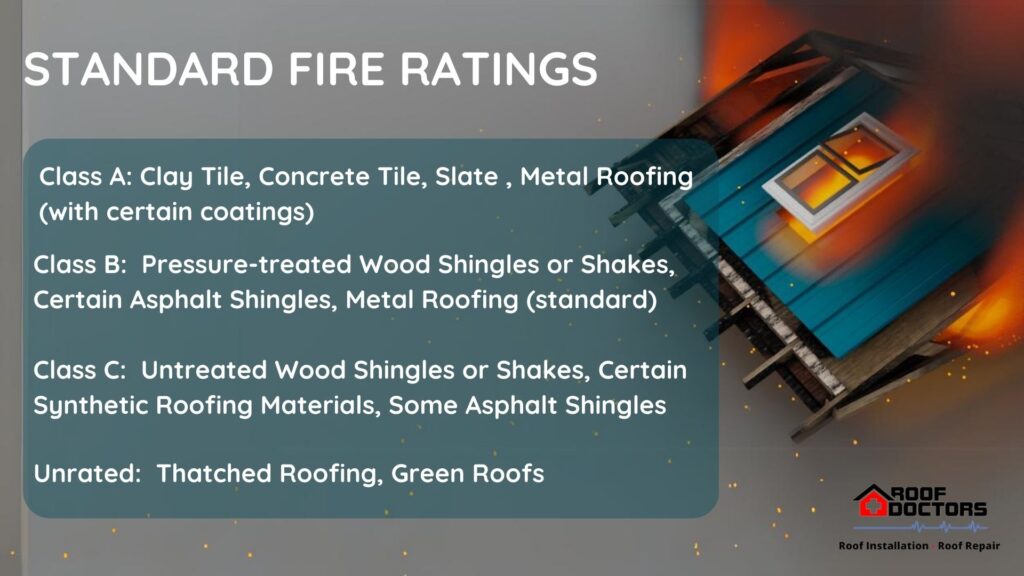
A roof inspection by a roofing specialist should be scheduled if you are unsure or wish to check the kind of roof. So, how can you determine whether a roofing material is fire-resistant? The roofing industry uses Three standard ratings: Class A, B, and C.
- Class A: Class A roofing materials have proven their efficacy in the most stringent fire testing. They provide the best defense against flame penetration as stand-alone roofing products with remarkable resistance to surface flame spread without requiring chemical treatments or additional underlying roofing materials. Exceptional resistance to surface flame spread.
- Class B: Research has shown that Class B roofing materials are effective against mild fire exposure. Some roofing materials could be mixed with chemicals that resist fire to satisfy Class B criteria.
- Class C: Only light fire exposure has demonstrated the effectiveness of Class C roofing materials. Reconstituted wood products and untreated wood shakes are examples of class C materials.
- Unrated: Avoid using unrated roofing materials in high-risk fire areas, as they don’t fit into any of the mentioned groups
The California Code On Fire-resistant Materials
California’s Building Code Chapter 7A aims to lessen the susceptibility of dwellings to wildfires and is applicable to all new developments situated in State Responsibility Areas (SRAs) and the greatest fire severity zones in Local Responsibility Areas (LRAs).
However, building a home above Chapter 7A regulations might be necessary to assure greater wildfire resistance, given the severity of California’s wildfire dangers and the rising number of homes being built in wildfire-prone locations. Comprehending the relative expenses of constructing homes resistant to wildfires in California can help shape future policy and decision-making around wildfires.
An aluminum coating is an exception to this general rule since its low melting point necessitates testing. To achieve the Class A (by assembly) classification, installation involves using an extra material underneath the aluminum coating.
Class A assembly rating can be obtained by pressure-impregnated wood shakes treated with a fire-retardant chemical. In California, the Office of the State Fire Marshal (OSFM) must approve using wood shakes treated with a fire retardant after they have undergone a natural weathering exposure test.
To be used in California, wood shakes must be listed on the OSFM Building Materials Listing Program. Wood shakes and shingles sprayed with fire retardants are prohibited in certain localities inside and outside California.

6 Fire-Resistant Roofing Materials for Your California Home
California is one of the most fire-prone states in the country. The top five biggest wildfires in the Golden State occurred in 2020, with an estimated damage of up to $10 billion.
Protecting your property is a top priority as a homeowner in the region. Fire-resistant roofing can serve as the first line of defense for your home. If you have plans to build, remodel, or re-roof, consider the following fire-resistant products for your project.
- Asphalt Shingles
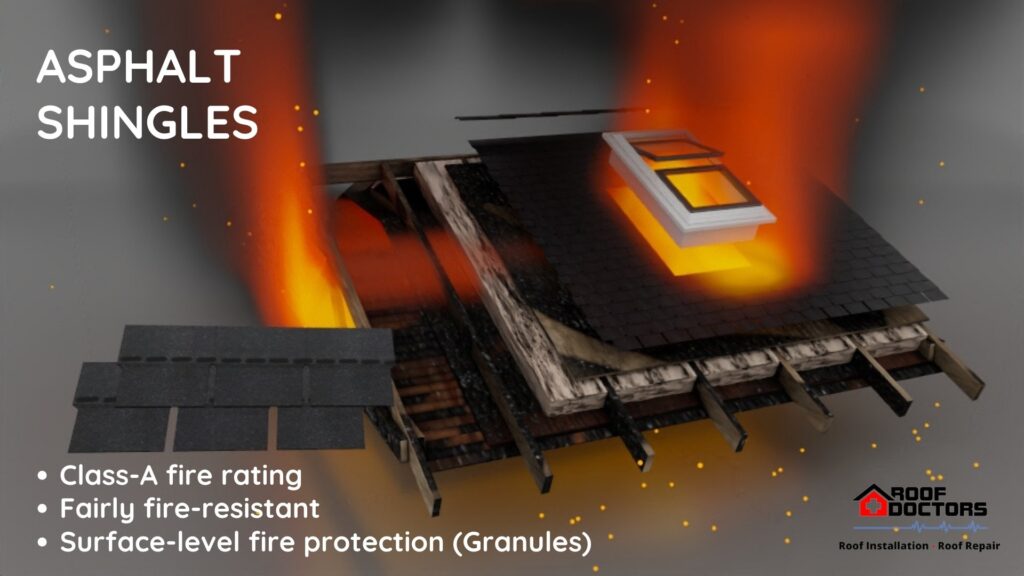
Composite asphalt glass fiber shingles are low-cost, easy to install, and resilient. Asphalt shingles, unlike wood ones, can resist catching fire for up to two hours, making them both fairly fire-resistant and extremely affordable.
For better performance, manufacturers saturate fiberglass mats with shingles and apply a final coating of colored mineral granules. To obtain a Class A fire rating, asphalt shingles are covered in granules that provide them with surface-level fire protection. Compared to non-combustible roofing materials like metal, asphalt is more prone to catching fire if flames make contact with it underneath.
Asphalt shingles with fiberglass backing offer fire protection when used with fire-resistant underlayment, earning a Class A classification for exceptional fire resistance.
- Metallic Roofs
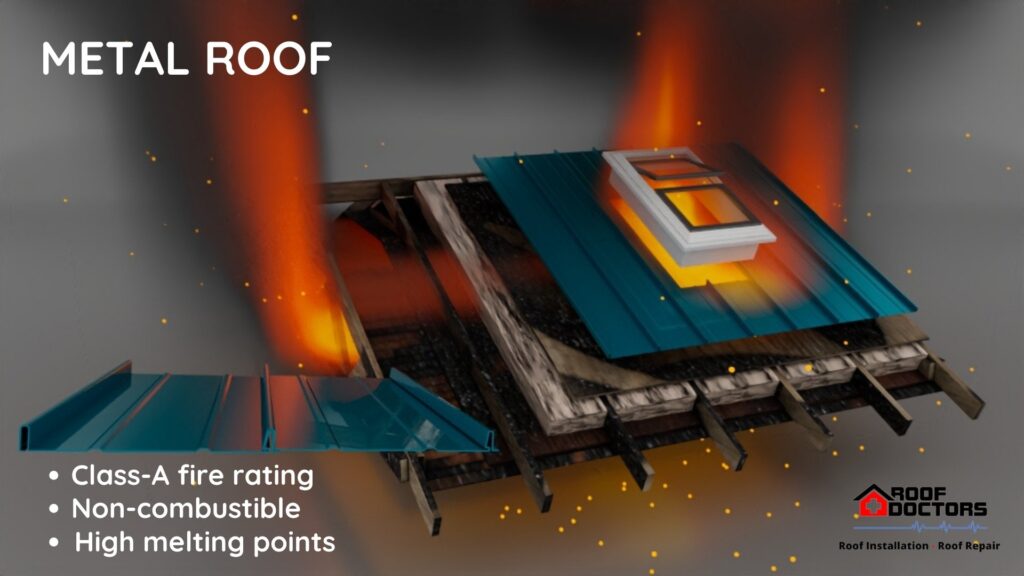
In California, metal roofs are now popular to create wildfire-resistant homes. Metal roofing can melt over time but undergoes combustion in relatively few fires, as they often fail to reach the required high temperatures. Ensure the metal roofing system you choose undergoes Class A testing, as not all systems maintain the same quality standards.
Fire-Resistant Roofing Materials and Property: While metal roofs are Class A Assembly-rated, additional materials are needed for high performance. Optimal wildfire-resistant measures include fire-resistant underlayment and noncombustible roofing elements like fiber-cement fascia, metal gutters, guards, and drip edge.
Metal roofing is an expensive option initially, but it will cost less in the long run. The lifespan of these roofing systems is 40–70 years. Metal alloys, like copper, zinc, steel, and stainless steel, offer various color and style options, broadening the choices for customers.
- Slate Roofs
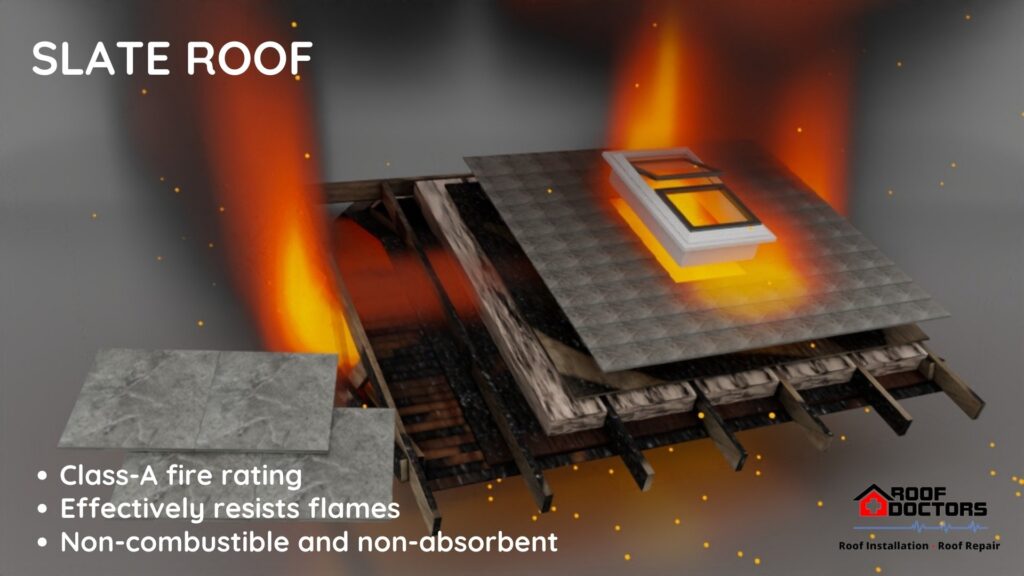
Slate is a beautiful and durable natural roofing material. With a Class A rating, the non-combustible and non-absorbent material is perfect for the fire-prone California region.
As slate is a rock, it effectively resists flames, avoiding melting or warping under high temperatures. Modern roofing pros use advanced reinforcement tech for slate roofs, ensuring strength. Innovations mitigate weight concerns, creating durable structures with ease.
The added benefit of natural beauty from your slate roof will improve the overall appearance of your house. This option may be advantageous for homeowners who have older properties or who favor aristocratic architecture.
- Synthetic Roofing Shingles
Due to their notable fire resistance, synthetic shingles are an ideal roofing choice for California homes. If you’re aiming for a budget-friendly re-roofing option, synthetic shingles are a reliable system to safeguard your home. Crafted from eco-friendly materials like polyurethane, these shingles surpass ordinary asphalt in durability and weather resistance.
In contrast, while wood shake shingles showcase natural beauty, they have the drawback of fire vulnerability. Consider wooden shingles treated with fire retardant to achieve that rustic aesthetic with enhanced protection.
Synthetic wood shingles emulate the look of natural wood shakes or tiles without compromising on fire resistance. These materials excel with minimal heat transfer and self-extinguishing features, ensuring safety in fires. Their prolonged lifespan and UV resistance make them ideal for both aesthetics and durability.
- Clay and Concrete Tile
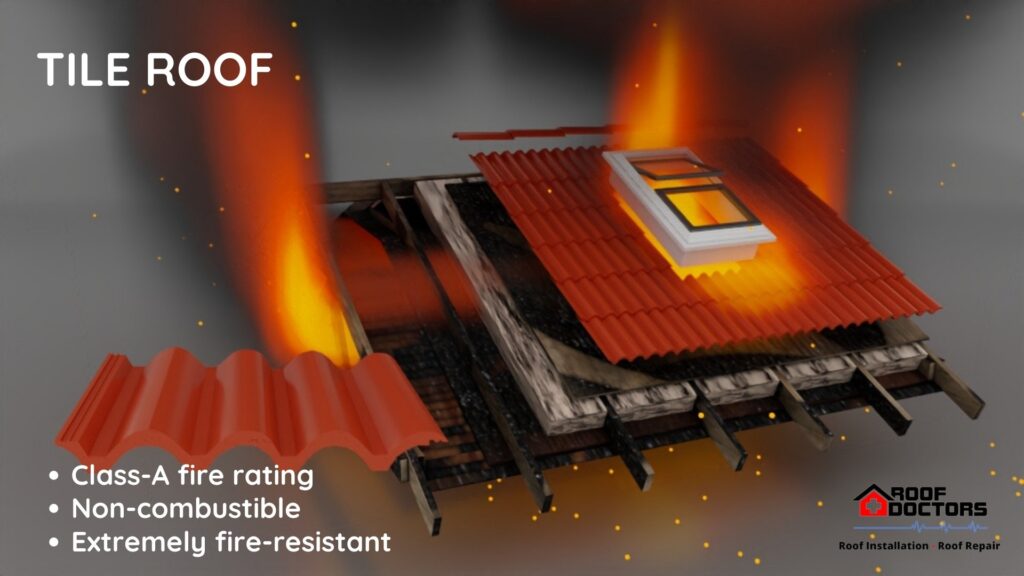
Clay and concrete tiles are resilient roofing options with distinct characteristics. Clay tiles, derived from natural clay and kiln-baked, offer durability and fire resistance. Marketed as terracotta tiles, they maintain a natural look and are customizable in various colors during production. On the other hand, concrete tiles, composed of Portland cement, sand, marble powder, and pigments, undergo kiln hardening for weather resistance and fire resistance, making them suitable for California homes.
In a Southern California comparison, the Optimum home featured pricier clay barrel-style tiles, emphasizing fire resistance with noncombustible end-caps. Metal components, including drip edge, gutters, and guards, were chosen over vinyl for added durability.
Fire-resistant roofing Materials, like concrete and clay tiles, offer a cost-effective alternative for property protection. Ensure flame resistance by choosing fire-rated options, although installation challenges may necessitate additional structural support due to their weight.
Additional Fireproofing Measures
California is a great place to live, but you must take extra measures to protect your home against severe fires. The roof is the largest component of your home and the most exposed, requiring special consideration.
Fire-resistant materials impede the fast spread of fire on your property and minimize the risk of damage.

- Under-Eave Area
While essential for building design, eaves introduce potential vulnerabilities that can facilitate fire ignition. In open-eave construction, embers may accumulate in gaps between blocking and rafters, posing a risk of ignition. Open eaves, if exposed to flames, can also trap heat, accelerating lateral fire spread once the under-eave area ignites.
Vents in the under-eave space, designed to allow air into the attic, present another potential pathway for fire. During a wildfire, these vents may permit wind-blown embers into the attic, potentially causing the house to burn from the inside out. While traditional vents were susceptible to flames and embers, recent designs incorporate flame- and ember-resistant features.
Homes in northern and southern California opted for an enclosed (soffited) eave design in pursuing wildfire-resistant home design. Fiber-cement, three-coat stucco, and flame- and ember-resistant strip vents improve fire protection compared to open-eave design in Baseline and Enhanced homes.
- Removing Debris Accumulation
Attention to fire-resistant roofing materials and property vulnerabilities is essential. Moreover, gaps in roof covering at the ridge and edges can attract birds and rodents. To prevent nesting, sealing these spaces with flat, barrel-shaped tiles, metal, and cement roofs is crucial.
Furthermore, the materials these creatures use in their nests are often highly flammable. This poses a significant risk of ignition by embers. Flames from such ignited debris may bypass the protection of a Class A-rated roof covering, reaching structural support members. Therefore, it is imperative to address these vulnerabilities in order to enhance overall fire safety measures.
Additionally, wind-blown debris, including leaves and pine needles from nearby trees, accumulates on roofs and gutters. Wind-blown embers can ignite dry debris on roofs, potentially extending flames to the roof edge and adjacent siding.
Even with Class A fire-rated roof coverings, vertical surfaces near the roof edge remain exposed to flames from ignited debris. Regularly clear roof and gutter debris to minimize fire risk and ensure home safety. Removing vegetative buildup is crucial for overall protection.
- Proper Rain Gutters
Choosing the right material for gutters in fire-prone areas is critical to mitigating the risk of flames reaching the roof edge. When ignited by embers, burning debris in gutters threatens the roof’s edge, necessitating a material that can withstand the exposure. While the use of metal angle flashing at the roof edge offers added protection, the choice between a metal (noncombustible) gutter and a vinyl (plastic) gutter impacts how each handles fire risk.
Keeping gutters clear of debris is paramount, as the accumulation can easily ignite during a wildfire. A metal gutter, being noncombustible, remains in place while debris burns, protecting the roof edge. In contrast, a vinyl gutter, being plastic, quickly melts and detaches, potentially contributing to ground-level fire spread. Regular inspection and debris removal from gutters, particularly before fire season, are essential preventive measures.
Additionally, implementing a vegetation management plan can minimize debris accumulation. Pre-evacuation tip: Plug downspouts, fill gutters with water to minimize debris ignition, enhance fire protection for your home.
The 6 Most Common Roof Problems In California Heat?
Prioritize wildfire protection with effective, fire-resistant roofing materials for California homes. Now that we’ve covered the essential choices to fortify our roofs against such risks, let’s transition to the next critical consideration under the California sun – tackling the six most common roof problems intensified by the relentless heat.
Prioritizing fire-resistant roofing materials and proactive maintenance ensures our property withstands flames and thrives in California’s challenging climate, enduring scorching temperatures. Shield roofs in California from heat-related issues with fireproof solutions, ensuring durability and prevention of broader problems.


